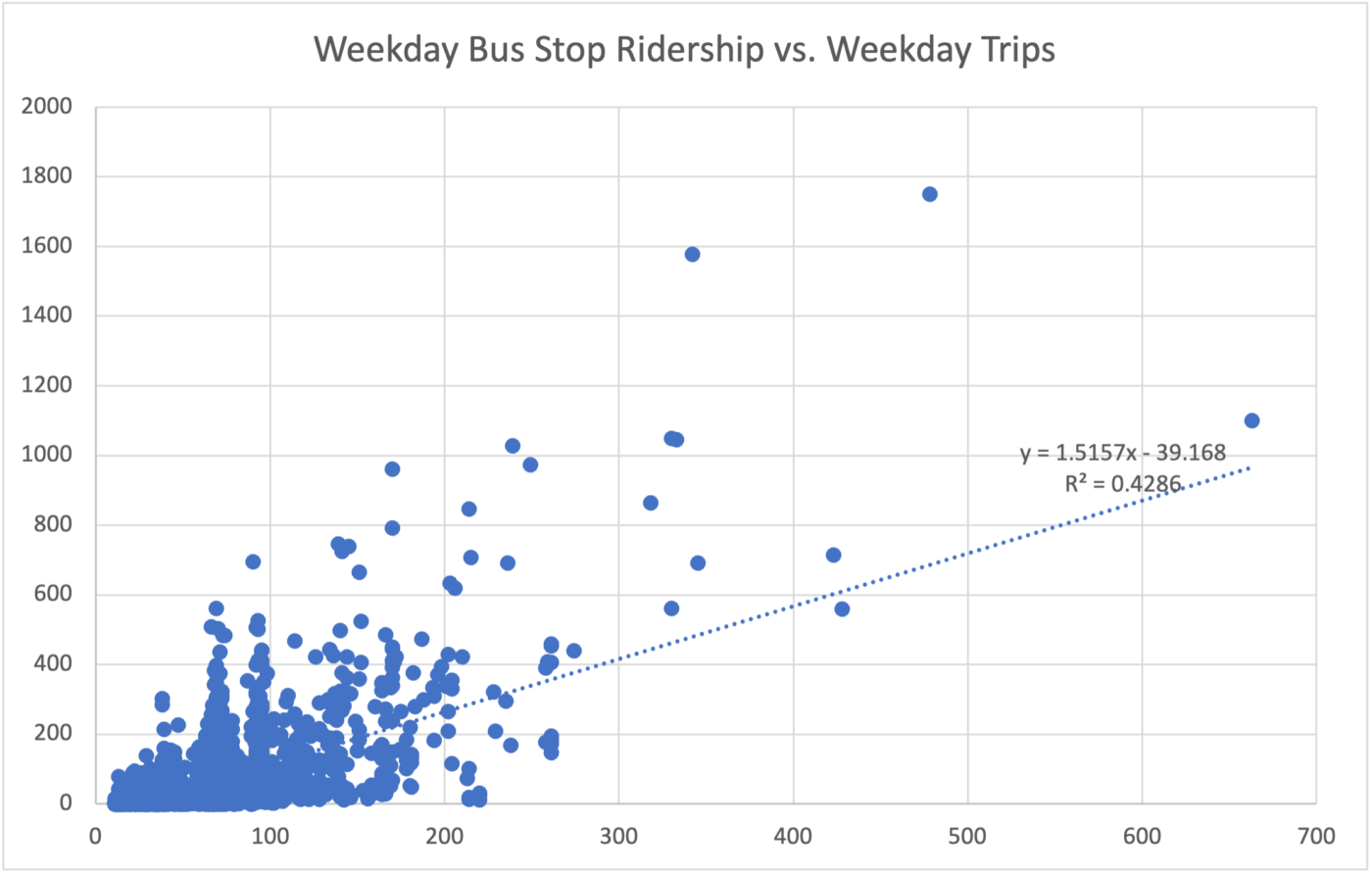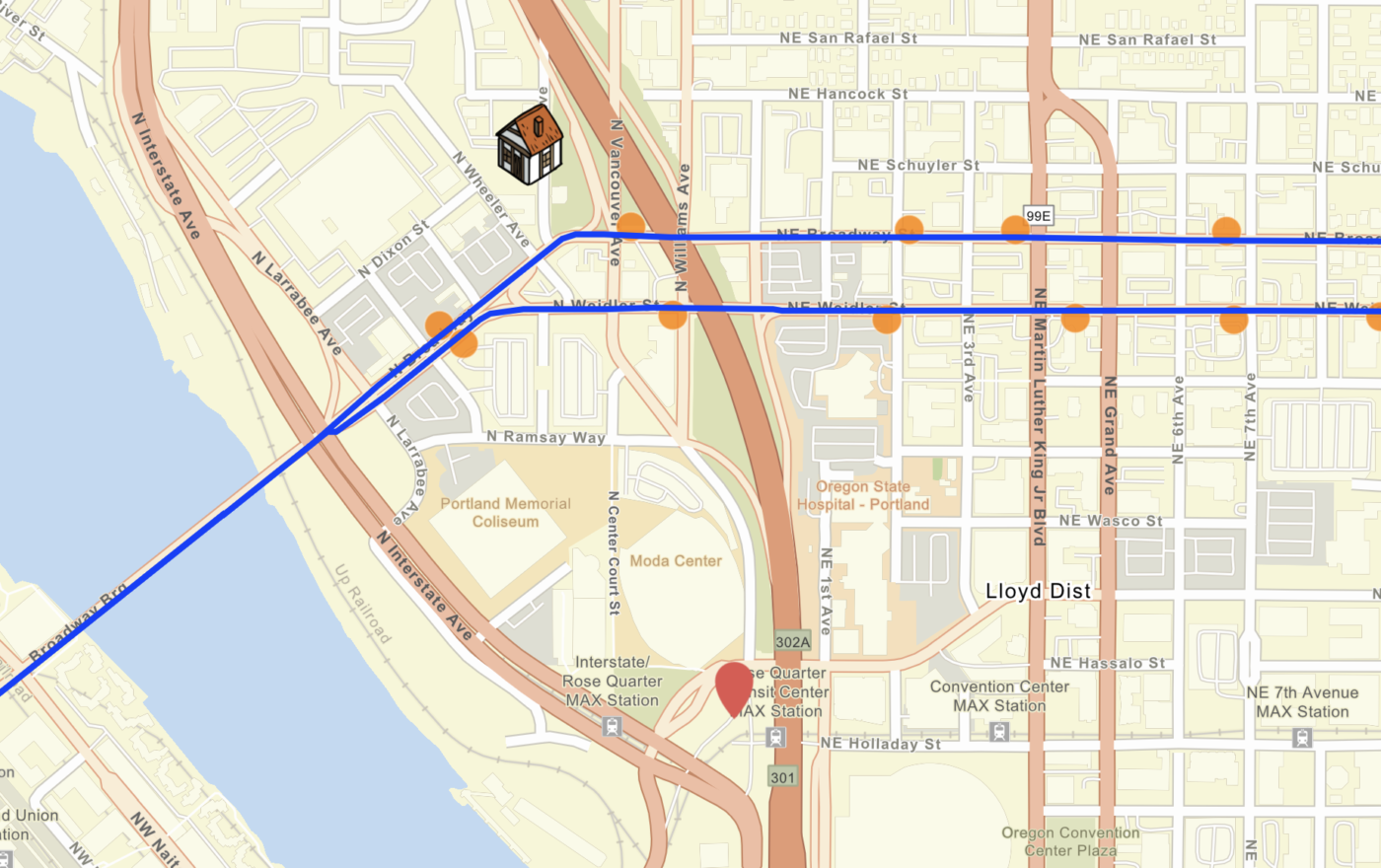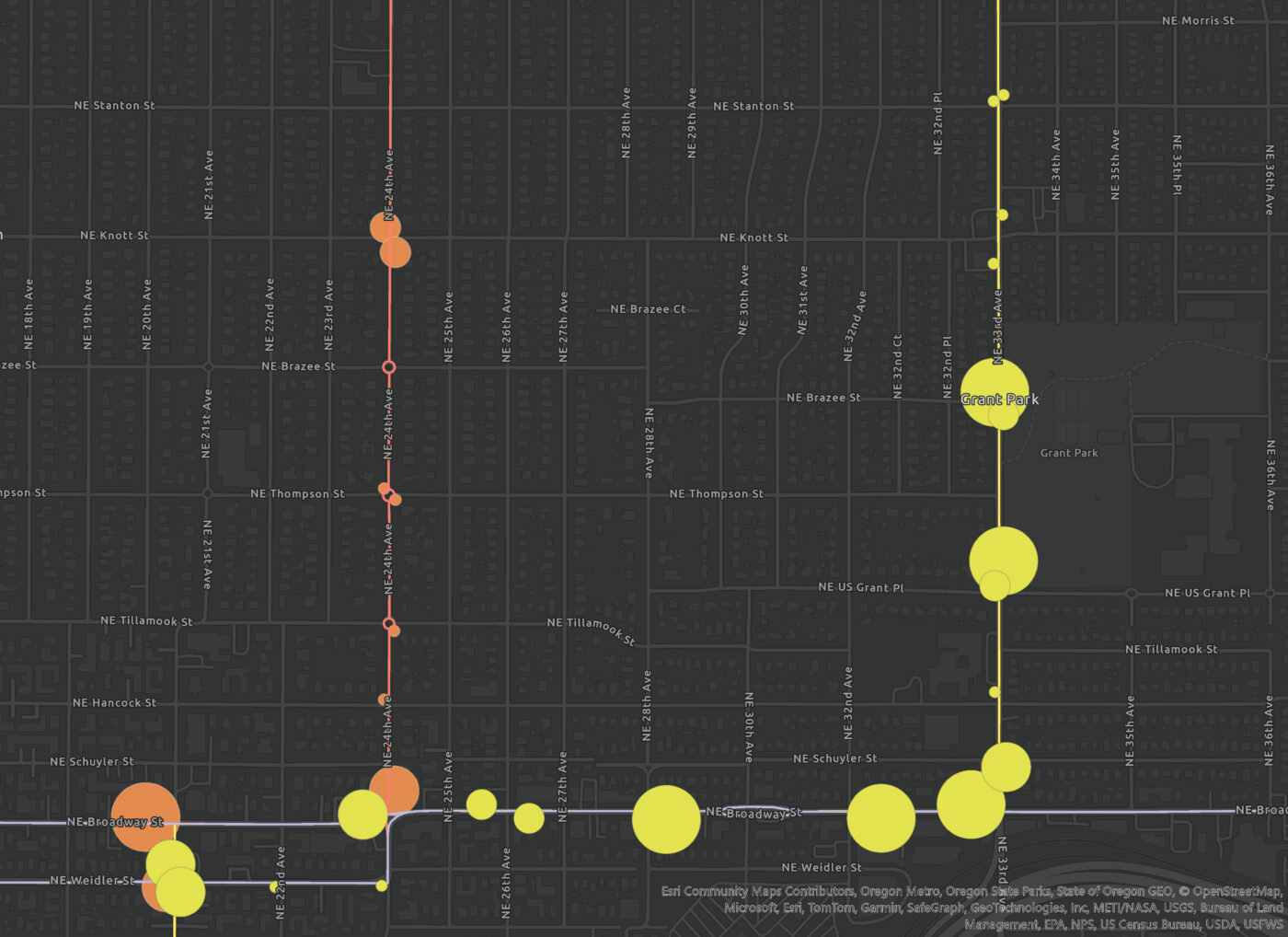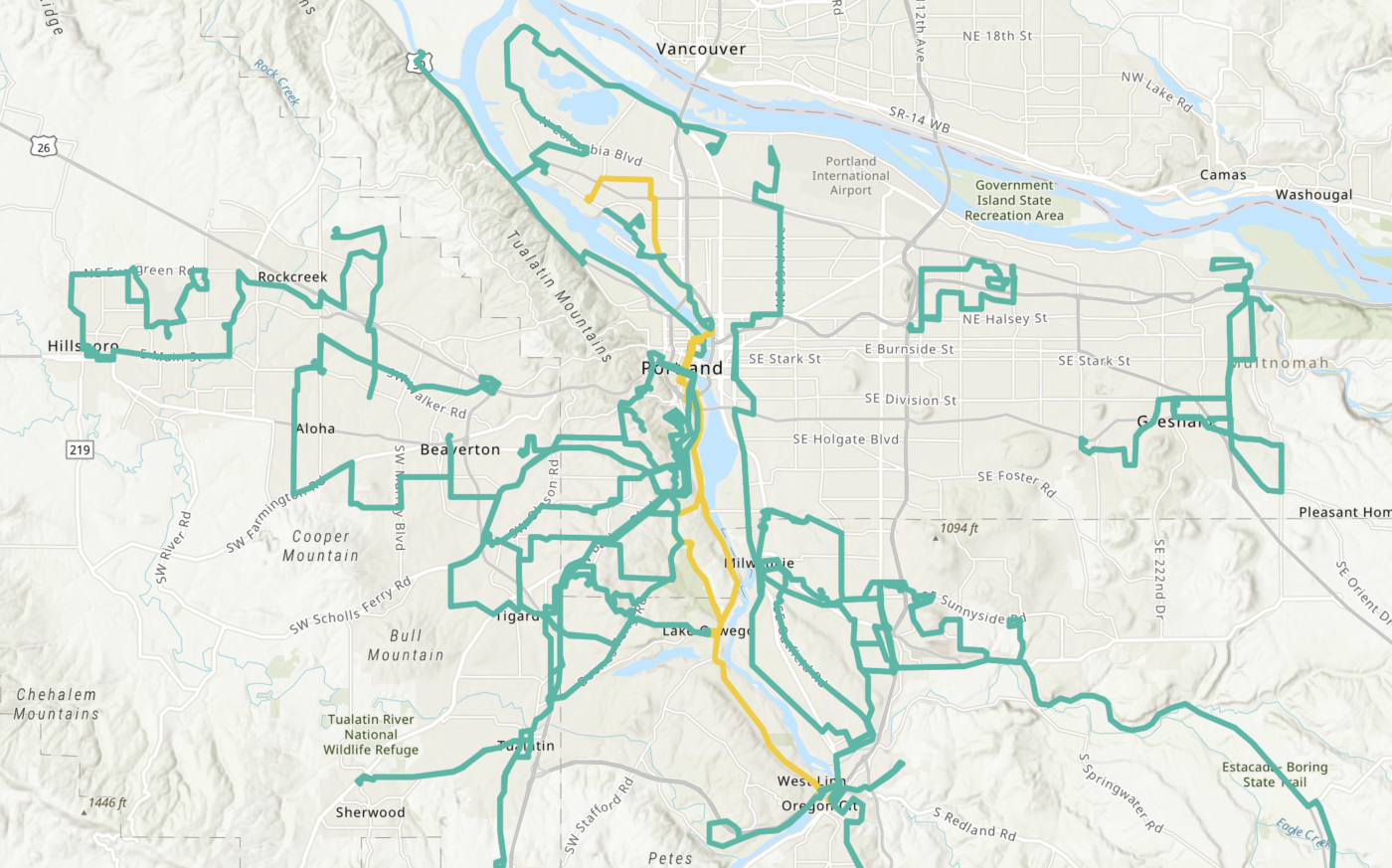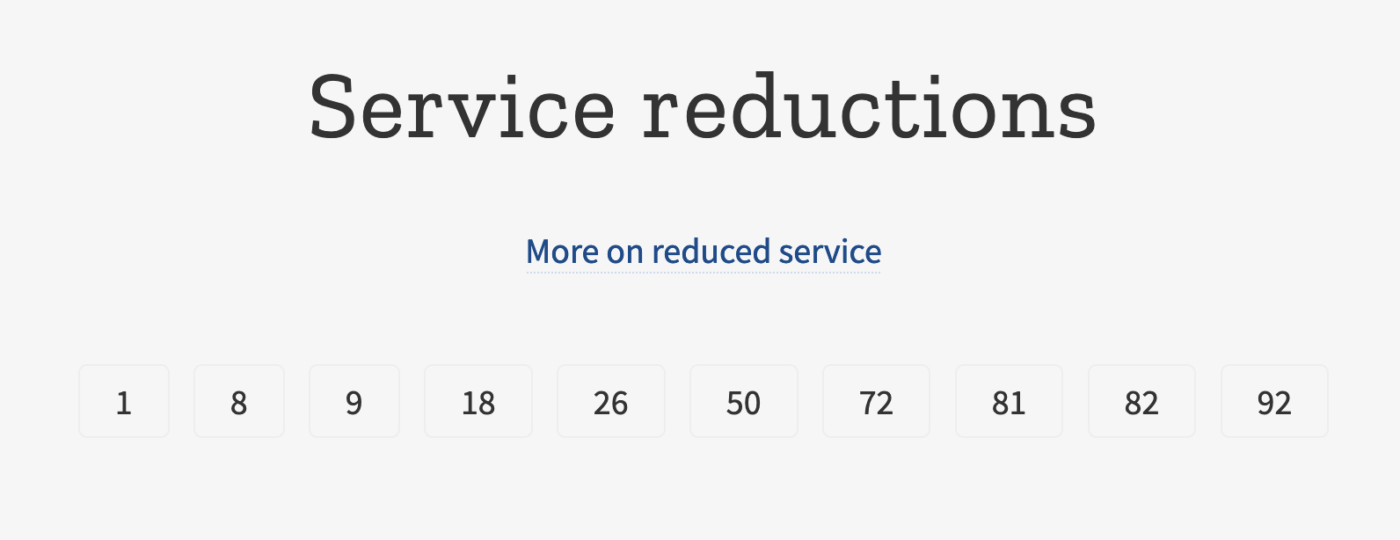— This is a guest article written by Andrew Lindstrom, who writes about infrastructure, transportation and urban spaces on his City Hikes blog.
TriMet has a problem, but it’s not the one you’re thinking of. Safety and rider comfort is still a big deal, and they are certainly struggling on that front – but I want to focus on a more pressing issue, the nuts and bolts of schedules and service changes. This all began with a supposed upgrade of part of the #17 to Frequent Service (“every 15 minutes or less most of the day, every day”) which resulted in no additional buses being run. It bugged me then, and it bugs me now so let’s take a look at the history, mystery, and wonder of the scheduled service on the 17-Holgate/Broadway.
To begin, we should understand what the service was back in the ancient days of 2021. The simplest way to do this is looking at the schedule, so let’s take a peek.
The first thing to note here is the total number of buses running on a given weekday – 61, with 58 making the entire trip. Second, if we look at the typical frequency during the day we see buses every 20 minutes during the afternoon, every 10 to 12 minutes during the morning peak, and every 12 to 15 minutes during the evening peak. Night service is every 30 minutes, with the final trip passing through downtown at about 12:20.
The focus on the morning peak over the evening peak is directional, since the south leg on Holgate (heading into downtown in the morning) tends to be busier than the north leg on Broadway (heading out of downtown in the evening). The “rush hour to downtown” focus is also a clear legacy of pre-Covid ridership, something TriMet has been earnest to rethink in their current batch of service changes.
Now let’s take a look at the current service pattern – remember, this is after a supposed “upgrade” to Frequent Service.
So we can see here that there are 60 total buses – one fewer than in 2021 – with just 36 making the entire trip. So how can we consider this to be “Frequent Service”? Well for starters, this is only getting that designation on the southerly leg on Holgate, so let’s focus there for now. The typical non-rush frequency during the day is up to every 15 minutes, while both the morning and evening peaks are down to the same 15 minute service. Evening service is still every 30 minutes, with the last bus going through downtown at 12:20, though it is slightly worse than before with 4 rather than 5 buses leaving downtown after 9:30 PM.

 Typical headway between 4 and 5 PM, 2021 (left) and 2024 (right). Darker colors indicate longer headways
Typical headway between 4 and 5 PM, 2021 (left) and 2024 (right). Darker colors indicate longer headwaysEvidently, I find the new schedule to hardly be an upgrade from the old one. It’s a net reduction in overall service, frequencies in the morning and evening rushes are worse, and the night service is slightly worse. This is not just an issue with the #17, basically all the TriMet bus routes have seen service cuts since 2020, usually just to the point of having service technically qualify as “Frequent Service”, though usually just on weekdays. Remember, the designation does in fact say “every day”!
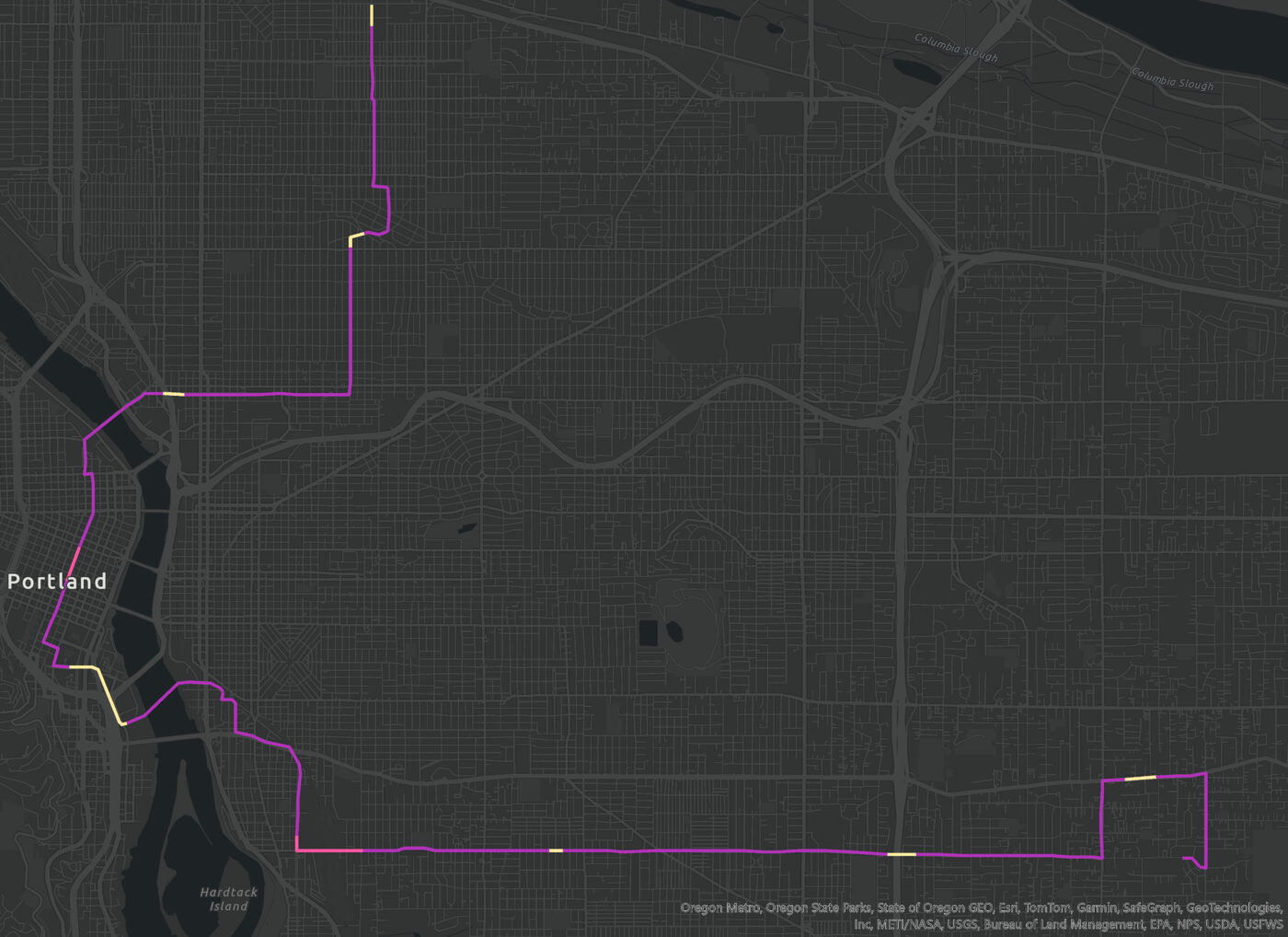
 Typical headway between 12 and 1 PM, 2021 (left) and 2024 (right). Darker colors indicate longer headways
Typical headway between 12 and 1 PM, 2021 (left) and 2024 (right). Darker colors indicate longer headwaysWhile we’ve focused on weekdays here, I have to give some limited credit for improved Saturday service. Going from 33 buses a day in 2021 to 60 today is great, but current service levels arguably fall short of the Frequent Service designation – with 15 minute headways spanning roughly 9 AM to 5:30 PM. I don’t feel comfortable calling that “most of the day”, even if it is an improvement from prior service levels.
That’s enough background on the #17, let’s get to the real piece of interest. We are in the middle of a series of planned service changes, and the #17 is a big part of the current batch. The allegedly most controversial is the removal of the service through northeast on 24th/27th (a legacy of the Broadway Line streetcar) but before we talk about that I want to highlight a much more pressing issue: Union Station, the Broadway Bridge, and Lower Albina.
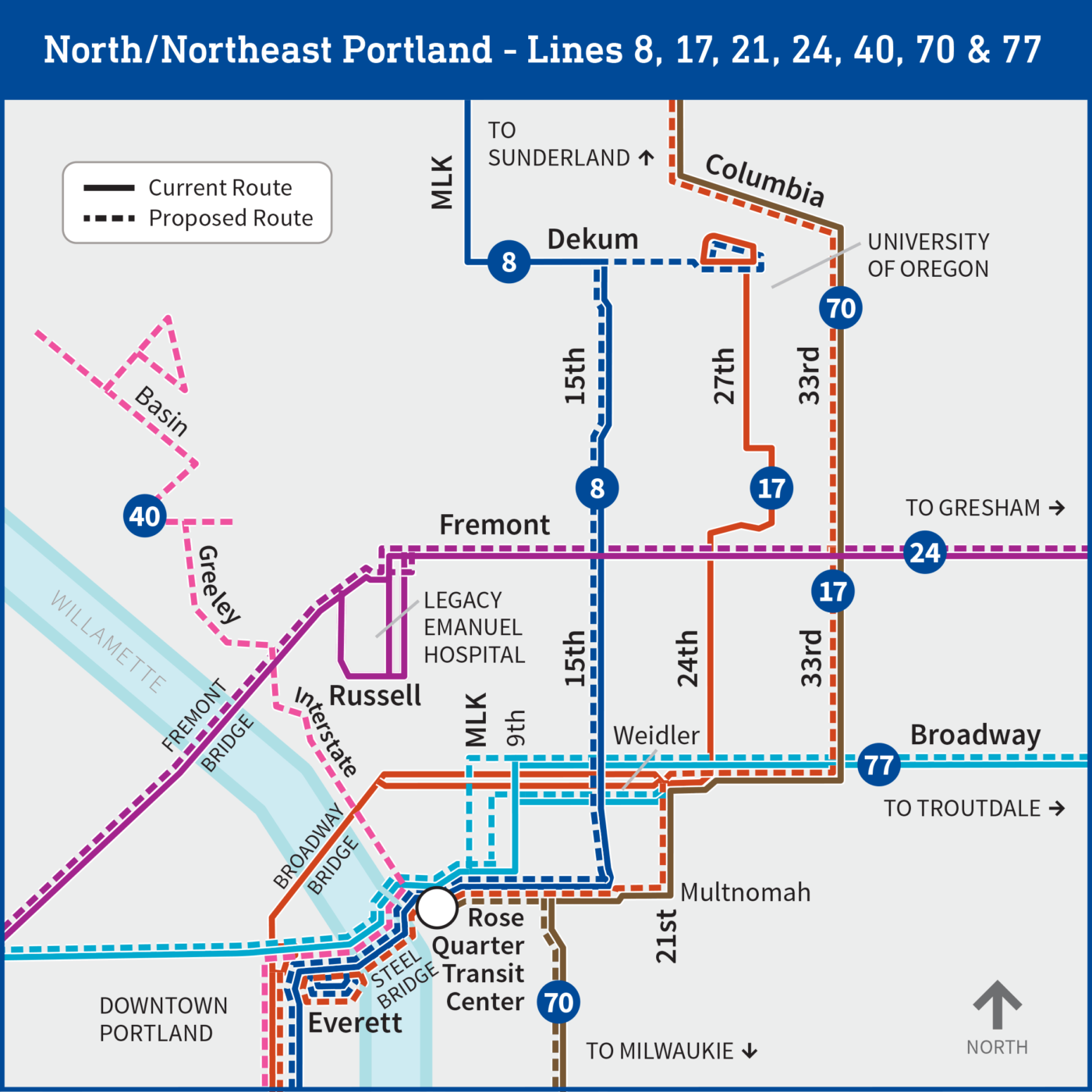 Proposed changes in N/NE Portland. A difficult map to parse.
Proposed changes in N/NE Portland. A difficult map to parse.
With so many routes on this image – showing both before and after – you could be forgiven for barely noticing the #17 moving away from the Broadway Bridge. There are a whole host of ramifications for this, with the removal of service from Union Station being near the top of the list. As it stands now, just two buses (the #17 and FX2) directly serve the station, along with the MAX Green and Orange/Yellow lines. The #9 could serve the station, as it overlays in the parking lot nearby, but instead you’ll have to walk to Davis. This is a point I have repeatedly brought up to TriMet (every time I have to make that walk), but they have assured me it’s impossible for a bus to manage the complicated maneuvering required to drive around the block.
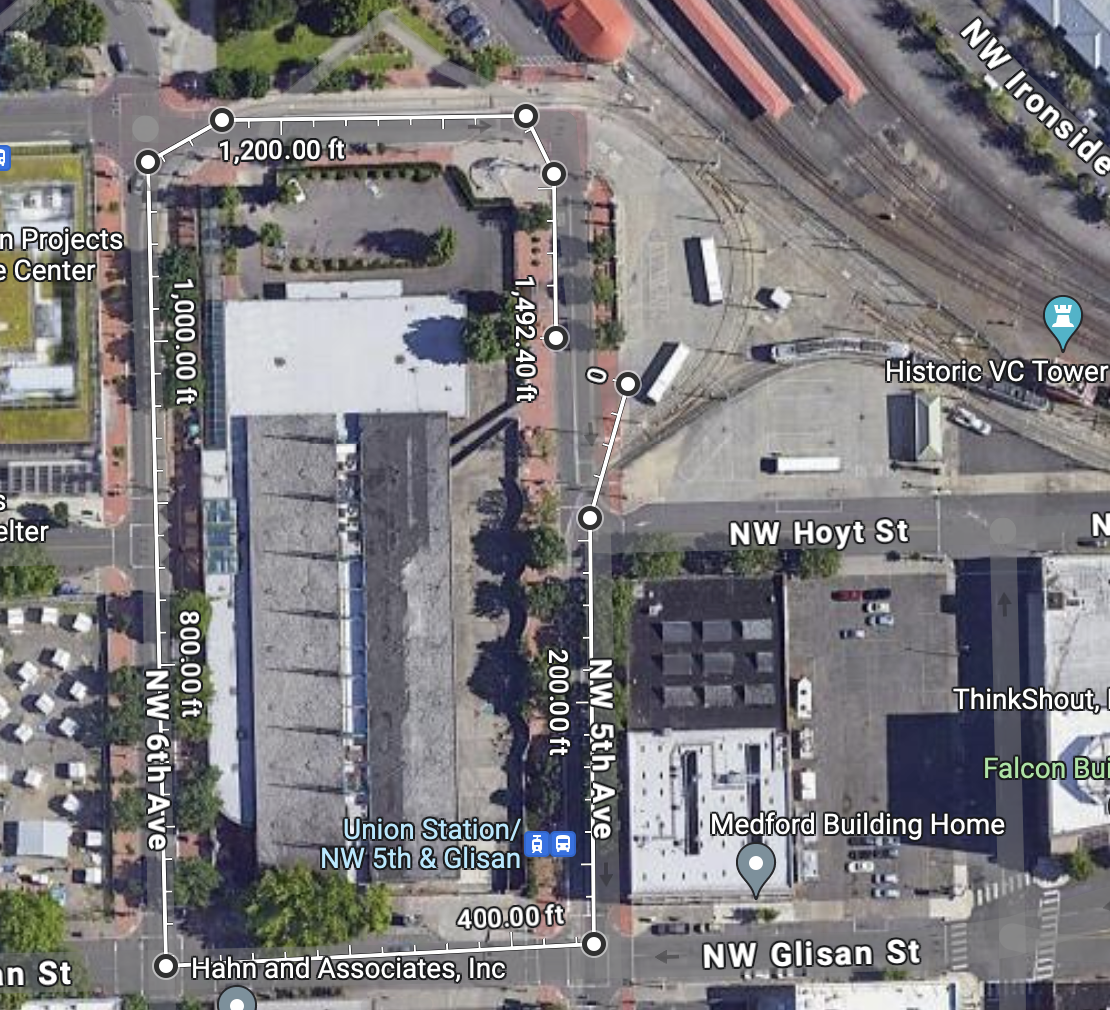 Like come on, it’s not that far. Also, they could just put the stop such that you could pull directly out into it from the lot!
Like come on, it’s not that far. Also, they could just put the stop such that you could pull directly out into it from the lot!
Sorry, this is evidently a sore spot for me. The point is, Union Station is poorly served by TriMet, especially for buses. All Steel Bridge-bound buses present the same issue that the #9 does – a walk to Everett to either get to or leave the station, more than a quarter mile away from the station.
This stop is also is a high ridership stop for the #17, despite getting less than 40 buses a day on a given weekday. At 1.5 riders per bus, it ranks in the top 10% of bus stops in the system, and it also provides access to a litany of social services directly adjacent to Union Station. It’s the only transit route that connects the station directly to NE Portland. All of these are reasons to leave service to the station, and I can’t stress enough how frustrating it is to be a train aficionado and having to beg my public transit agency to serve the train station.

But it’s more than just Union Station that will be affected by removing the #17 from the Broadway Bridge, there are key areas of inner north and northeast Portland that are losing a significant amount of service.
Before we go further, it’s worth expanding on the relationship between ridership and service though. As this chart illustrates, there is a weakly positive relationship between more service and total ridership, with our slope indicating that we would expect another 1.5 riders to board for every extra trip we add after about the 40th trip of the day. This is a very simplistic model, and while an R^2 of 0.43 suggests just a weak correlation, I still think it’s a useful heuristic.
Now let’s get a handle on those areas near the Broadway Bridge and beyond, and what the ridership is in terms of riders boarding per bus on a typical weekday. For places where service is changing, it’s hard to gauge exactly how much service will be lost before schedules are released, but I’d like to give a brief overview of each segment affected. Keep in mind TriMet’s stated justification for moving service to 33rd is low ridership on 24th/27th, and that they have no stated justification for moving service away from the Broadway Bridge.
The first area of focus is the Broadway Bridge area, up to the intersection with the #8 on NE 15th. The light pink line shown (the #77) is being upgraded to Frequent Service and routed north to take over the stops lost by the #17 reroute, but will still cut out a transfer to the #4 at the corners of Broadway, Williams, Vancouver, and Weider (where the red and green lines meet).
The stops on the #17 get about one bus rider boarding per bus, and are adjacent to a low income housing project (Madrona Studios). It’s also worth pointing out that the forthcoming Albina Vision One project at Flint/Hancock is also currently best served by the #17 and that the #17 is the only bus that serves Lower Albina directly (the 4/44 skirt around the I-5 edge).
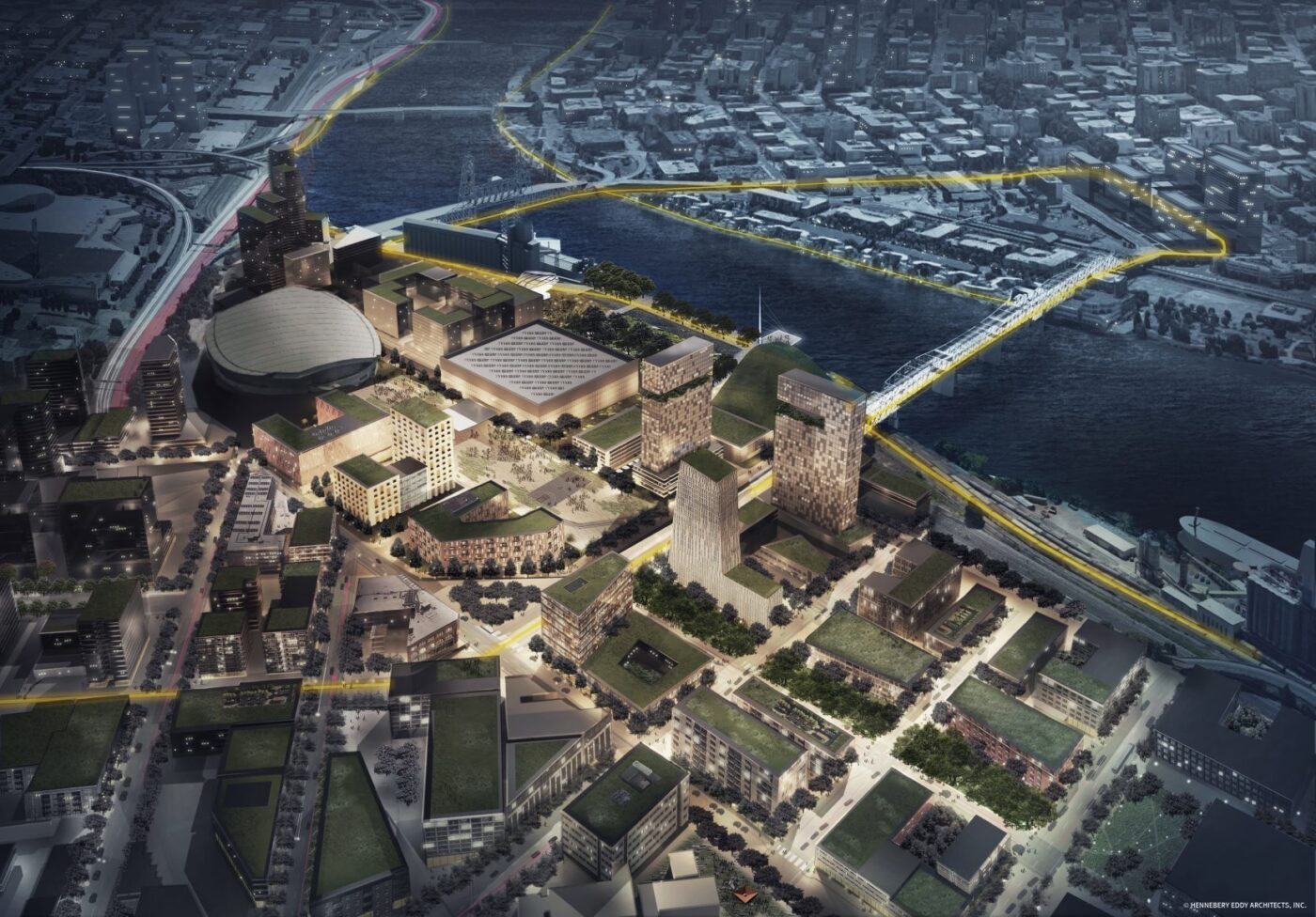 Albina Vision concept by Henberry Eddy Architects
Albina Vision concept by Henberry Eddy Architects
Let’s take a deeper look into Lower Albina, arguably the neighborhood in the city that has born the most damage from the freeway and urban renewal areas. This excellent piece from City Observatory tells the story better than I can, but given that the Portland Housing Bureau has invested $16 million into the first project by Albina Vision Trust, and transit access is high on the list of positives in the area the choice to move the #17 needs to face extreme scrutiny.
If the future vision of Lower Albina as rendered by Henberry Eddy Architects is to be achieved, surely we ought to be running buses over the Broadway Bridge.
Albina One, the first project in the Vision consists of 94 units, 100% of which are affordable (62 at 60% area median income, 32 at 30%). Marked as a house at N Flint near Hancock, it’s currently less than a quarter mile from the nearest stop on the #17 on Broadway/Weidler (route in blue, stops in orange).
If this change goes through, it will be just over half a mile from the nearest bus serving East Broadway and SE at the Rose Quarter Transit Center (marked in red). Not an unfathomably long walk, but certainly worse than the existing service. Cutting transit service to a landmark affordable housing project needs to have a lot more justification than the nothing that TriMet has provided on this front.
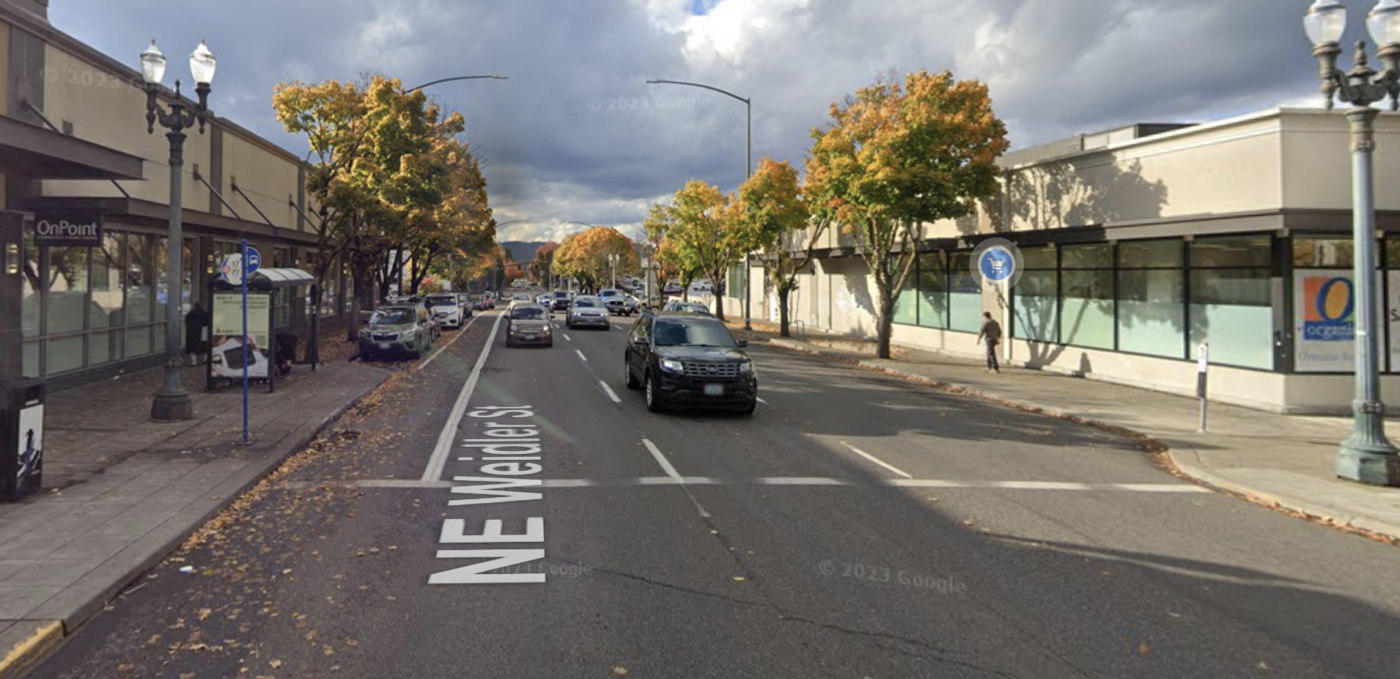
And before we leave the area, let’s look at the busiest stop on Lower Broadway – NE Broadway/Weidler and 12th. Located near the not-dead-yet Lloyd Center mall and at a major grocery store (Safeway), the Weidler stop ranks in the top 3% of busiest bus stops with 10 or more buses per day in terms of riders per bus (at 2.66, it’s 158/5360).
Currently, it gets 76 buses a day on a typical weekday on the #17 and #77. It’s unlikely that Frequent Service on the #77 would see that many buses, and the loss of the #17 will make some trips much less convenient to this area – particularly from downtown. Before Covid service cuts, this stop pair saw about 110 buses/day at each stop.
Further down Broadway, we arrive at 24th and 33rd. Currently, 33rd is served by the “crosstown” #70, which does not go downtown and offers reasonably frequent N/S options in inner east Portland on 11th and 12th (even if the span of service is bad). The on 33rd here see significantly more ridership, likely due to the presence of Grant High School.
But given the different utility that the #17 and #70 serve (downtown vs. crosstown), there are other confounding factors as to why 33rd gets more ridership than 24th.
Further north, near Killingsworth we see a more balanced ridership split between 27th and 33rd. Near 33rd and Killingsworth, there is a strong neighborhood commercial center with a grocery store, pharmacy, and a transfer to the #72 – TriMet’s busiest route.
The transfer to the #72 on Alberta/27th gets relatively less ridership, though at about one rider boarding per bus, that still puts it in the top 17% of stops on the bus network.
So is 33rd or 24th/27th busier? In absolute terms, it’s 33rd. More buses means more ridership after all. But in terms of riders per bus, it’s not exactly conclusive. 33rd gets more riders per bus at the high and medium range, but 24th/27th gets more at the low end. I don’t think a ridership distribution like this merits being called “low ridership”.
If NE 24th/27th are considered to be low enough ridership to justify a cut, there are thirty-five bus routes with fewer median riders boarding per stop. The astute of you may notice that the #70 is one of those buses! Some of these routes have been on the chopping block for years, but others are generally considered to be routes worth increasing service on.
The 35 in particular stands out to me. Highlighted in yellow, it serves Lake Oswego, Oregon City, and North Portland and a cut to a core route like this would generally be unthinkable. It isn’t the biggest ridership draw, and it doesn’t serve parts of the region generally thought of as equity focuses.
But still, it was singled out as a potential for an upgrade to Frequent Service in the original Forward Together service plan. I think that’s great, more buses are always welcome, but it also serves as a reminder to the political nature of service changes.
Upgrading a lower ridership line that serves rich suburban parts of the region to ameliorate concerns relating to tolling I-205 while cutting service to wealthy parts of inner Portland is just serving suburban interests at the expense of urban ones. While I (theoretically) understand that TriMet serves both urban and suburban Portland, public transit is more fiscally and socially sustainable in dense urban environments.
I want to be clear that I’m not against this upgrade to the #35. I’ve ridden the bus before and waiting for 20 minutes at the Lake O transit center was not fun. But given the current austerity as well as TriMet’s equity goals, the changes really stand out as strange.
Inner NE Portland is facing a service cut, and the entire construction of the new bus network isn’t great. Lower Broadway will likely go from 75+ buses on a weekday, roughly evenly split between downtown and NW services to likely less than 70 buses per weekday, all NW bound. Not to mention that section of lower Broadway got 110 buses a day in 2021 – that’s a total cut of 36%. Multnomah and 33rd will have worse mid-day service, with TriMet only committing to 15 minute service in peak hours on the new #17, which is probably only going to be slightly more frequent in terms of overall service than service existing on the #70. 24th/27th is losing service altogether, and we are looking at having just one bus serve the most important intercity rail station in the state.
Despite this, there is little evidence on the proposal that the net result of this is less service with fewer travel options. It reads as minor changes, or little tweaks to service – in reality, it’s probably close to a 20% cut in service hours to inner NE – and that’s on top of cuts that have already happened like the earlier changes to the #17.
Reading the TriMet code, I feel that the descriptions of these changes are close to running up against the requirement for describing the changes. I’m not trying to be hyperbolic, but it’s alarming that service is being cut substantially – especially from lower Broadway – and the only text mentioning a change of service is how the #77 will “move to NE MLK/Grand to serve more of the Broadway-Weidler corridor”. I don’t doubt that TriMet’s notice has met their own rules and regulations, but I question if they are meeting the spirit.
Although I will point out that the cut to NE 24th/27th, and the move to the Steel Bridge constitutes 32% of the route-miles on the #17, and TriMet is required to provide a hearing when there is a change that constitutes 25% or more of the route-miles of a given transit route. Clearly, this public engagement process is the manner in which they are doing this but is a header describing “Route Changes”, with text about discontinued service on a web forum enough? Surely the TriMet legal team thinks so, and I’m not trying to make the case that they are outside the legal expectation. Rather, I think they are outside the public expectation – especially considering that former bus route changes specifically listed service cuts (you can view these at your leisure, archived here ).
When it comes down to it, I can’t in good faith support the decision as it stands now to end service on NE 24th/27th, and I can’t sit idly by and watch as Union Station bus service continues to be cut to oblivion. I understand that TriMet is on shaky ground with the public now, but I don’t feel that the current trends are doing much to improve their standing. Moving the #17 from the Broadway Bridge to the Steel Bridge is such a minor change, but it cuts service for Union Station, at least one affordable housing apartment complex, and threatens the future of useful transit in Lower Albina. That is a big deal, and it needs to be taken seriously.
It’s late in the comment period, but there are still public meetings going on until this Thursday, February 1st and online comments are accepted through February 11th. Make your voice heard! If you find all of these changes to just one bus route to be dizzying, imagine the ramifications of the bus that may be changing in your neighborhood. TriMet does mostly good work, but they are not immune to poor decisions and it’s your job as a member of the public to understand exactly what they mean when they change schedules.
This entire post has been an exercise in falling down a rabbit hole, and I wouldn’t have even noticed the loss of service to Lower Albina if I hadn’t been concerned about the loss of service to Union Station. Small route changes can have big negative impacts, and your voice matters in preventing them. Leave a comment while there’s still a chance to, and show up in person to make your voice heard. I’ll be at 70 NW Couch St, Rooms 142/144 on February 1st between 12:00 and 2:00 pm. I hope to see you there.
Python and R code to create data for maps, parse ridership information, and more is in this github repo Ridership data from TriMet is from this .pdf GTFS data was downloaded from this site that logs historic transit feedsYou can see the Excel Workbook that I made charts from and did calculations in here if you really wantMaps were created in ArcGIS Online, licensed through Portland StatePieces from City Observatory on Albina are below




